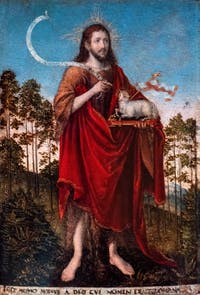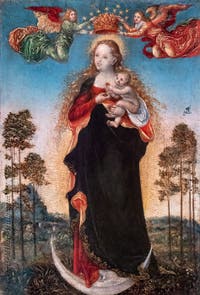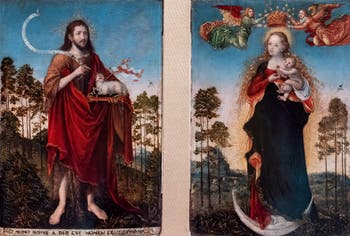Museums Ambrosiana | Castello Sforzesco | Poldi Pezzoli
Poldi Pezzoli Artists | Location | Opening Hours Tickets | Authorizations
Artists Bellini | Botticelli | Canaletto | Carriera | Cranach | Daddi | Francesca | Giordano | Guardi | Lippi F. | Lotto | Luini | Mantegna | Montagna | Memling | Palma | Pinturicchio | Pollaiolo | Raphael | Tiepolo | Titian | Weapons Room
Lucas Cranach the Elder “Saint John the Baptist” and “Immaculate Conception with the Child and two Angels” Poldi Pezzoli Museum in Milan in Italy
Lucas Cranach the Elder (4 October 1472 — 16 October 1553) “Saint John the Baptist”
Painting - Oil on Wood (18.3 x 12.5 cm) 1550 — 1552
Saint John the Baptist This Saint John the Baptist painting by Lucas Cranach the Elder is part of a diptych whose right part is dedicated to the Virgin Mary and the Infant Jesus.
The two paintings present a similar landscape that creates continuity between them.
Saint John the Baptist is represented with his traditional camel skin tunic, which is here partly covered with a scarlet-red drape like the edge of the book he is holding in his left hand; John the Baptist carries the sacred book of the Gospels richly bound in black and gold, on which rest the Lamb and the cross with the resurrection standard.
The saint's light-shrouded face expresses his unwavering faith and the serenity, peace and love he shares with the Lamb.
At the bottom of the table, we can read the inscription: “Here was a man sent by God, his name is Giovanni”, quoting the Gospel according to John (1, 6).
Lucas Cranach the Elder took particular care of this painting, where the minuscule details show the meticulousness of his work for a work that is only 18 centimetres high.
This means that the tiny hairs of the camel skin tunic, the chiselled gold of the cross, and the head of the Lamb with a particularly expressive look all these details can be likened to illuminations.
Lucas Cranach the Elder (4 October 1472 — 16 October 1553) “Immaculate Conception with the Child and two Angels”
Painting - Oil on Wood (18.3 x 12.5 cm) 1550 — 1552The Virgin Mary is represented here by Cranach in the form of the Immaculate Conception to illustrate her purity, who was exempt from original sin before her birth.

Immaculate Conception Cranach, therefore, recalls here that this supernatural character, which distinguished Mary from other humans, was a privilege that predestined her to become the mother of Christ.
Numerous depictions of the Immaculate Conception were made following religious authorities' official and definitive recognition of the belief in 1483.
Therefore, Lucas Cranach the Elder could also represent the Virgin Mary in the form of the Immaculate Conception, which he painted standing on the moon and crowned by two angels.
Cranach repeated here the description of the Apocalypse where the Immaculate Conception appeared as the woman enveloped in the sun, crowned with twelve stars with her feet placed on the moon.
She carries the Child on her left arm while her right hand delicately holds a red rose, a symbol associated with the wounds of Jesus, who accepts her by stretching out his arms.
She wears a superb black cloak embroidered with gold on her scarlet dress, the same colours as the holy book worn by Saint John the Baptist.

Lucas Cranach the Elder Her red hair surrounds her sweet face and descends on her shoulders. She looks down slightly as if she were coming down from the sky.
While in the Assumption, she is represented with her eyes raised to the sky.
We will admire the delicacy of the colours of the sky, as well as the finesse of the painted details, in particular the drapes of the angels and especially the magnificent hair of the Virgin, all painted in such a small picture.
The Immaculate Conception was the subject of numerous theological controversies that lasted until 1483 when Pope Sixtus IV published a bull establishing the liturgical feast of the Immaculate Conception.
Sixtus IV had the famous Sistine Chapel built in the Vatican in honour and memory of the Immaculate Conception.
Artists Bellini | Botticelli | Canaletto | Carriera | Cranach | Daddi | Francesca | Giordano | Guardi | Lippi F. | Lotto | Luini | Mantegna | Montagna | Memling | Palma | Pinturicchio | Pollaiolo | Raphael | Tiepolo | Titian | Weapons Room
Poldi Pezzoli Artists | Location | Opening Hours Tickets | Authorizations
Museums Ambrosiana | Castello Sforzesco | Poldi Pezzoli
Back to Top of Page

